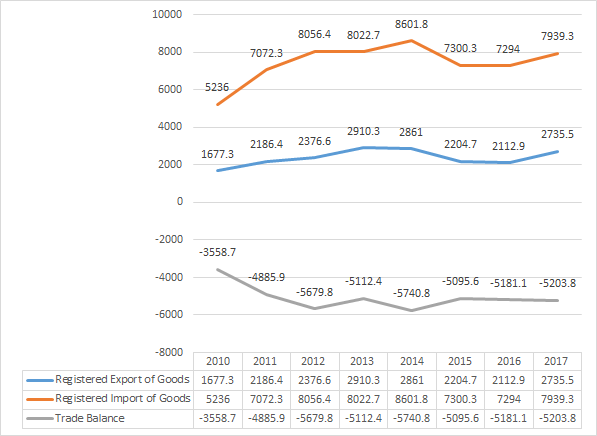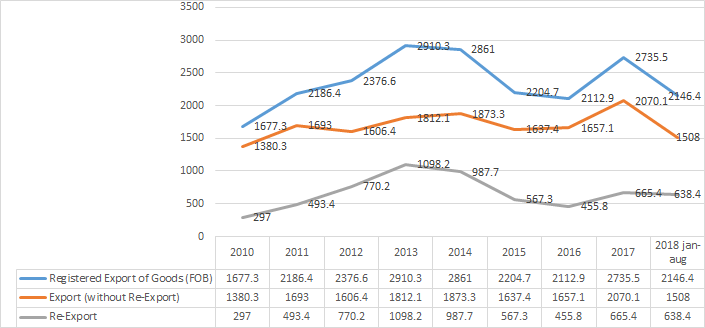Verdict: FactCheck concludes that Roman Gotsiridze’s statement is TRUE.
Resume: Historically, import to Georgia has always significantly exceeded export. The trade balance (the difference between volumes of export and import) to GDP ratio was 25.3% in 2017 which is 1.6 percentage points less as compared to the same figure of the previous year. In 2014-2015 these figures were 25.6% and 30.8%, respectively.
Re-export constitutes a substantial part (24.3% in 2017) of Georgia’s export. The growth of re-export is a positive trend itself. However, a large share of re-export in the total export is undesirable because a country profits much less from re-export as compared to export. Therefore, whilst analysing export statistics, it is relevant to pay attention to this particular aspect.
In 2017, Georgia’s total export was USD 2.735 billion. Of this amount, USD 665 million is re-export. These figures slightly mismatch the numbers named in the MP’s statement.
Analysis
On 19 September 2018, on the Pirispir talk show, United National Movement member, Roman Gotsiridze, stated: “Georgia’s export, in fact, was USD 2 billion in 2017. Officially, Georgia’s export amounts to USD 2.7 billion but USD 0.7 billion is a re-export because we import and export oil as well as we import and export cars.”
Of necessary initial note is that import has historically always significantly exceeded export in Georgia. The trade balance (export minus import) to GDP ratio was 25.3% in 2017 which is 1.6 percentage points less as compared to the same figure of the previous year. In 2014-2015 these figures were 25.6% and 30.8%, respectively. The absolute figures of foreign trade are given in Graph 1.
Graph 1: Georgia’s Export and Import and Trade Balance (USD Million)
 Source: National Statistics Office of Georgia
In regard to 2017 export statistics per se, Roman Gotsiridze’s figures mostly match the National Statistics Office’s data. The registered export of goods was USD 2.735 billion in this period. USD 665 million (24.3%) of this amount constituted re-export.
Graph 2: Export and Re-Export in 2010-2018 (USD Million)
Source: National Statistics Office of Georgia
In regard to 2017 export statistics per se, Roman Gotsiridze’s figures mostly match the National Statistics Office’s data. The registered export of goods was USD 2.735 billion in this period. USD 665 million (24.3%) of this amount constituted re-export.
Graph 2: Export and Re-Export in 2010-2018 (USD Million)
 Source: National Statistics Office of Georgia
The definition of re-export is an export of goods which were produced outside of a country’s customs territory; that is, they were imported in the first place. In the case of re-export, Georgia acts as a kind of trade intermediary because re-exported goods are not produced in Georgia. The re-export of cars is a well-known and relevant example for illustration. In terms of export volumes, cars are the number-two export item with a value of USD 243 million (11.3% of the total export). Georgia does not produce small cars so this figure, for example, can be categorised as a re-export case.
To further clarify the difference between export and re-export profits, we will discuss their impact upon the GDP. The GDP structure is shown in its calculation formulae: GDP = C + G + I + NX. In this equation, C is consumption, G is state purchases, I is investments and NX is net export (export minus import). All things being equal, the growth of export causes the growth of the GDP. The impact of the production of export goods is reflected in other aspects such as increased employment and generated incomes. Re-export is a combination of import and export; therefore, it causes a decrease in net export and GDP in the import phase whilst it increases net export and the GDP in the export phase of imported goods. Usually, this entails a net positive effect – the export value of re-exported goods exceeds their import value. It is precisely the difference between the export and import values of re-export which constitutes a country’s profit.
Re-export does not have a large impact upon jobs and the growth of production which needs to be taken into account whilst discussing exports. Let us assume that Germany produces a car valued at EUR 50,000. The production of cars needs labour and capital whilst this process creates jobs and stimulates the economy. After exporting the car, Germany’s GDP will increase by EUR 50,000. Let us again assume that a Georgian resident purchased this car, imported it to Georgia and then sold it in Azerbaijan for EUR 55,000. The effect of this transaction is statistically reflected in the growth of Georgia’s export by EUR 55,000. However, the net profit for Georgia from this transaction, which is growth of net export, is only EUR 5,000.
Of note is that re-export is not a negative thing itself and the growth of re-export is considered as a positive change. However, it is natural that the total profit from re-export for a country is naturally less as compared to export. Therefore, the growth of re-export in itself is welcoming although undesirable when its size is large in the structure of export.
Source: National Statistics Office of Georgia
The definition of re-export is an export of goods which were produced outside of a country’s customs territory; that is, they were imported in the first place. In the case of re-export, Georgia acts as a kind of trade intermediary because re-exported goods are not produced in Georgia. The re-export of cars is a well-known and relevant example for illustration. In terms of export volumes, cars are the number-two export item with a value of USD 243 million (11.3% of the total export). Georgia does not produce small cars so this figure, for example, can be categorised as a re-export case.
To further clarify the difference between export and re-export profits, we will discuss their impact upon the GDP. The GDP structure is shown in its calculation formulae: GDP = C + G + I + NX. In this equation, C is consumption, G is state purchases, I is investments and NX is net export (export minus import). All things being equal, the growth of export causes the growth of the GDP. The impact of the production of export goods is reflected in other aspects such as increased employment and generated incomes. Re-export is a combination of import and export; therefore, it causes a decrease in net export and GDP in the import phase whilst it increases net export and the GDP in the export phase of imported goods. Usually, this entails a net positive effect – the export value of re-exported goods exceeds their import value. It is precisely the difference between the export and import values of re-export which constitutes a country’s profit.
Re-export does not have a large impact upon jobs and the growth of production which needs to be taken into account whilst discussing exports. Let us assume that Germany produces a car valued at EUR 50,000. The production of cars needs labour and capital whilst this process creates jobs and stimulates the economy. After exporting the car, Germany’s GDP will increase by EUR 50,000. Let us again assume that a Georgian resident purchased this car, imported it to Georgia and then sold it in Azerbaijan for EUR 55,000. The effect of this transaction is statistically reflected in the growth of Georgia’s export by EUR 55,000. However, the net profit for Georgia from this transaction, which is growth of net export, is only EUR 5,000.
Of note is that re-export is not a negative thing itself and the growth of re-export is considered as a positive change. However, it is natural that the total profit from re-export for a country is naturally less as compared to export. Therefore, the growth of re-export in itself is welcoming although undesirable when its size is large in the structure of export.
 Source: National Statistics Office of Georgia
In regard to 2017 export statistics per se, Roman Gotsiridze’s figures mostly match the National Statistics Office’s data. The registered export of goods was USD 2.735 billion in this period. USD 665 million (24.3%) of this amount constituted re-export.
Graph 2: Export and Re-Export in 2010-2018 (USD Million)
Source: National Statistics Office of Georgia
In regard to 2017 export statistics per se, Roman Gotsiridze’s figures mostly match the National Statistics Office’s data. The registered export of goods was USD 2.735 billion in this period. USD 665 million (24.3%) of this amount constituted re-export.
Graph 2: Export and Re-Export in 2010-2018 (USD Million)
 Source: National Statistics Office of Georgia
The definition of re-export is an export of goods which were produced outside of a country’s customs territory; that is, they were imported in the first place. In the case of re-export, Georgia acts as a kind of trade intermediary because re-exported goods are not produced in Georgia. The re-export of cars is a well-known and relevant example for illustration. In terms of export volumes, cars are the number-two export item with a value of USD 243 million (11.3% of the total export). Georgia does not produce small cars so this figure, for example, can be categorised as a re-export case.
To further clarify the difference between export and re-export profits, we will discuss their impact upon the GDP. The GDP structure is shown in its calculation formulae: GDP = C + G + I + NX. In this equation, C is consumption, G is state purchases, I is investments and NX is net export (export minus import). All things being equal, the growth of export causes the growth of the GDP. The impact of the production of export goods is reflected in other aspects such as increased employment and generated incomes. Re-export is a combination of import and export; therefore, it causes a decrease in net export and GDP in the import phase whilst it increases net export and the GDP in the export phase of imported goods. Usually, this entails a net positive effect – the export value of re-exported goods exceeds their import value. It is precisely the difference between the export and import values of re-export which constitutes a country’s profit.
Re-export does not have a large impact upon jobs and the growth of production which needs to be taken into account whilst discussing exports. Let us assume that Germany produces a car valued at EUR 50,000. The production of cars needs labour and capital whilst this process creates jobs and stimulates the economy. After exporting the car, Germany’s GDP will increase by EUR 50,000. Let us again assume that a Georgian resident purchased this car, imported it to Georgia and then sold it in Azerbaijan for EUR 55,000. The effect of this transaction is statistically reflected in the growth of Georgia’s export by EUR 55,000. However, the net profit for Georgia from this transaction, which is growth of net export, is only EUR 5,000.
Of note is that re-export is not a negative thing itself and the growth of re-export is considered as a positive change. However, it is natural that the total profit from re-export for a country is naturally less as compared to export. Therefore, the growth of re-export in itself is welcoming although undesirable when its size is large in the structure of export.
Source: National Statistics Office of Georgia
The definition of re-export is an export of goods which were produced outside of a country’s customs territory; that is, they were imported in the first place. In the case of re-export, Georgia acts as a kind of trade intermediary because re-exported goods are not produced in Georgia. The re-export of cars is a well-known and relevant example for illustration. In terms of export volumes, cars are the number-two export item with a value of USD 243 million (11.3% of the total export). Georgia does not produce small cars so this figure, for example, can be categorised as a re-export case.
To further clarify the difference between export and re-export profits, we will discuss their impact upon the GDP. The GDP structure is shown in its calculation formulae: GDP = C + G + I + NX. In this equation, C is consumption, G is state purchases, I is investments and NX is net export (export minus import). All things being equal, the growth of export causes the growth of the GDP. The impact of the production of export goods is reflected in other aspects such as increased employment and generated incomes. Re-export is a combination of import and export; therefore, it causes a decrease in net export and GDP in the import phase whilst it increases net export and the GDP in the export phase of imported goods. Usually, this entails a net positive effect – the export value of re-exported goods exceeds their import value. It is precisely the difference between the export and import values of re-export which constitutes a country’s profit.
Re-export does not have a large impact upon jobs and the growth of production which needs to be taken into account whilst discussing exports. Let us assume that Germany produces a car valued at EUR 50,000. The production of cars needs labour and capital whilst this process creates jobs and stimulates the economy. After exporting the car, Germany’s GDP will increase by EUR 50,000. Let us again assume that a Georgian resident purchased this car, imported it to Georgia and then sold it in Azerbaijan for EUR 55,000. The effect of this transaction is statistically reflected in the growth of Georgia’s export by EUR 55,000. However, the net profit for Georgia from this transaction, which is growth of net export, is only EUR 5,000.
Of note is that re-export is not a negative thing itself and the growth of re-export is considered as a positive change. However, it is natural that the total profit from re-export for a country is naturally less as compared to export. Therefore, the growth of re-export in itself is welcoming although undesirable when its size is large in the structure of export.
Tags:








